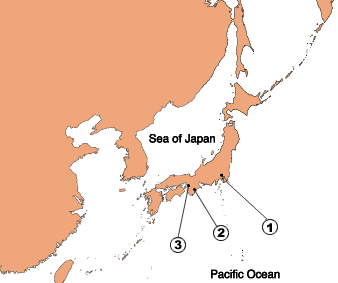| Web Japan > NIPPONIA No.28 > Japan Travelogue |
|
|
|
NIPPONIA No.28 March 15, 2004
|
|
Japan Travelogue |
 |
(1)Tokyo
(2)Kumano
(3)Osaka |
|
The Kii Peninsula juts out into the Pacific Ocean from central Honshu, Japan's largest island. The southern part of the peninsula, the Kumano district, has very little flat land—mountains dominate the landscape until they drop into the ocean and form a zigzag coastline. Blessed with a mild climate and plenty of rain, the so-called "3,600 Mountains of Kumano" are known for their cover of ancient forests of Japanese cedar and cypress, clear streams running through deep valleys, and waterfalls called the "48 Cascades of Nachi." When you visit this rich land of Mother Nature, it is not hard to understand why, in ancient times, people started believing that some trees, waterfalls, mountains and uniquely shaped rocks were sacred.
The focal points of this nature worship are the three Kumano Sanzan Shrines—Hongu Taisha, Hayatama Taisha, and Nachi Taisha. In the second half of the 11th century, emperors and aristocrats visited these shrines, initiating the most prestigious period of Kumano pilgrimages. Soon people from other ranks, from samurai to commoners, were coming in large numbers. The pilgrim road from Kyoto to Kumano, called the Kumano Kaido, had long lines of people, so many that the pilgrimages were jokingly called ari no kumano mode ("parade of ants on a pilgrimage to Kumano").
The Kumano Sanzan Shrines and the ancient roads leading to them are unique historical and cultural assets, and are scheduled to be recognized as World Heritage sites in June 2004.
The old Kumano Kaido Highway followed a number of routes. The most traveled one, the Nakahe-ji Road, climbs very steep slopes but was used by many pilgrims, who believed that the steeper the climb, the more likely their prayers would be answered. The road begins in Tanabe and cuts across the peninsula, going east through lush forests. We see stone statues along the way, erected in memory of pilgrims who died at these spots long ago.
After a long journey on foot, pilgrims would reach a place called Fushiogami Oji. From there they caught their first glimpse of one of the shrines, Hongu Taisha. Seen from afar, the torii gate and shrine buildings must have been a welcome sight for trekkers, after the long road they had traversed. Unfortunately, the main shrine building was swept away in a flood in 1889. The present one was rebuilt about 500 meters to the north.
Old ruins lie along the road to Hongu Taisha, and the area is associated with a number of legends. We come upon Sakamoto Isao, the leader of a group of narrative drama enthusiasts who explain the ruins, legends and the shrine's history to tourists. He grins, "When people hear about our interest in narrative drama they probably think we are all old fogies, but many of our members are in their 20s and 30s. Our group has about 30 members, and some can give tourist info in English." He told us that the name of his group is Hongu-cho Kataribe no Kai, and that walking with tourists along the old road has been very good for his health.
We follow the Nakahe-ji Road downhill along the Kumano River from Hongu, and come to the small city of Shingu on the ocean. Kumano Hayatama Taisha Shrine is located here. It is said that the shrine began through a belief in the divinity of huge rocks located nearby. Today, the main building with its bright red paint presents a magnificent sight.
One of the huge rocks is about 1 km south of there, at Kamikura Shrine. Stone steps lead to the shrine, rising at a steep gradient that seems to be more than 30 degrees. A god is believed to dwell in the rock behind the shrine. Facing the other way, we see the entire city of Shingu spread out far below.
Kamikura Shrine is famous for its Fire Festival, an epic event when runners rush down the stone steps at night, carrying flaming torches. One elderly local fellow shows us how it is done: "Like this, wham-bang, wham-bang!" His energy is astounding.
The last of the three Kumano shrines we visit is Nachi Taisha. Another god is said to live about 1 km north of the shrine, at a 133-meter high waterfall called Nachi Falls. The natural beauty of the cascading water is enhanced by the neighboring three-storied pagoda of a Buddhist temple, Seiganto-ji. It may seem strange that Shinto gods and a Buddhist temple coexist like this on the same plot of ground, but actually the two religions intermingled for centuries. Many beliefs were shared until a political decision was made in Japan in 1868 to separate them. At the waterfall is a living example of the old mixing of beliefs.
We climb to the lookout on Mount Nachi, on the other side of the waterfall. From there we look down on Katsuura, one of Japan's biggest tuna fishing ports. To the right lies the village of Taiji, once a base for whalers who hunted the traditional way. Beyond the small ports stretches the boundless horizon of the Pacific Ocean. From the seashore, an old pilgrim road climbs up to Nachi Taisha Shrine. This road, called Daimonzaka, was built around the 13th century, and the flagstone pavement remains to this day. It feels good, going back in time along the moss-covered stone steps, under the dense ancient forest of cedars.
The custom of making a pilgrimage to Kumano gradually died out, starting around the 14th century. But that kept the old roads and forests more or less untouched. The sights and scenes of ancient Japan are still alive in Kumano.
|
|
||||||||
|
||||||||
|